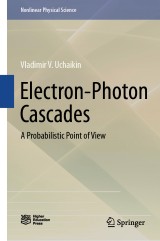Details

Electron-Photon Cascades
A Probabilistic Point of ViewNonlinear Physical Science
|
149,79 € |
|
| Verlag: | Springer |
| Format: | |
| Veröffentl.: | 29.07.2024 |
| ISBN/EAN: | 9789819975242 |
| Sprache: | englisch |
Dieses eBook enthält ein Wasserzeichen.
Beschreibungen
<div><div>This book demonstrates the practical application of an alternative approach to current problems in high-energy astrophysics. In high-energy astrophysical processes, single collisions are accompanied by the appearance of many secondary particles with different properties. To describe the infinitesimal evolution of such a system at a measurement instant, as is commonly done when deriving the kinetic equation for the system with conserved number of particles, one must know either its prehistory or the infinite family of many-particle distributions. An alternative to this approach is to use an adjoint (in the sense of Lagrange) mathematical formalism, where the independent active variable is the phase position of a primary particle generating the cascade, and the dependent variable has the form of a functional of the cascade as a whole, interpreted as the reading of some not necessarily linear (additive) detector. This approach is characterized by mathematical efficiency: no matter how many particles are formed in a cascade, the active argument of the desired functional always remains one particle. The second advantage is its generality: the formalization of the readings of the detector, which performs real measurements through the functionality of a random implementation of the cascade, allows it to be applied to a wide range of actually used devices and installations.</div><div><br></div><div>Readers will be able to master the fundamentals of particle astrophysics in the context of the latest developments in the field. It will benefit graduate students and established researchers alike, equipping them with the knowledge and tools necessary to design and interpret their own experiments and, ultimately, to address a number of questions about the nature and origin of cosmic particles that have arisen in recent research.</div></div>
<p>Introduction.- Cascade processes of high energy.- Forward (basic) equation for CP.- Backward (adjoint) equation.- Electrons and photons.- Analytical EPC theory.- EPC fluctuations theory.-Cascades in calorimeters.- SBCE method.- Monte Carlo modeling.- EAS structure.- Cherenkov radiation of EPC.- Transport in interstellar medium.- Relativistic EPC in intergalactic medium.-Conclusion: Cascade ages, similarity, universality. </p>
<p>Professor, Dr. of Phys. Math. Sci. Vladimir V. UCHAIKIN was born on 01.07.1941 in USSR and the head of the department of theoretical physics of Ulyanovsk State University, Russia. He is a known Russian scientist and pedagogue, an honored worker of Russian High School, a member the Council on the Complex Problem of Cosmic Rays of the Russian Academy of Sciences, and a member of the Russian Academy of Natural Sciences. He worked for Lomonossow’s Moscow State University and some other Russian universities, visited as an invited lecturer at Wrozlaw Polytechnik University (Poland), Nottingham Trent University (UK), Humboldt University, K. Weierstrass Institute, and Max Planck Institute (Germany), and served 2005–2006 асаdemic year as a visit professor in Case Western Reserve University (Ohio, USA).</p>
<div>This book demonstrates the practical application of an alternative approach to current problems in high-energy astrophysics. In high-energy astrophysical processes, single collisions are accompanied by the appearance of many secondary particles with different properties. To describe the infinitesimal evolution of such a system at a measurement instant, as is commonly done when deriving the kinetic equation for the system with conserved number of particles, one must know either its prehistory or the infinite family of many-particle distributions. An alternative to this approach is to use an adjoint (in the sense of Lagrange) mathematical formalism, where the independent active variable is the phase position of a primary particle generating the cascade, and the dependent variable has the form of a functional of the cascade as a whole, interpreted as the reading of some not necessarily linear (additive) detector. This approach is characterized by mathematical efficiency: no matter how many particles are formed in a cascade, the active argument of the desired functional always remains one particle. The second advantage is its generality: the formalization of the readings of the detector, which performs real measurements through the functionality of a random implementation of the cascade, allows it to be applied to a wide range of actually used devices and installations.</div><div><br></div><div>Readers will be able to master the fundamentals of particle astrophysics in the context of the latest developments in the field. It will benefit graduate students and established researchers alike, equipping them with the knowledge and tools necessary to design and interpret their own experiments and, ultimately, to address a number of questions about the nature and origin of cosmic particles that have arisen in recent research.</div>
Addresses a number of questions concerning the nature and origin of cosmic particles in recent research Considers the phenomena in the framework of a measurement procedure mapping random samples of Markov branching process Finds a way of presentation that is understandable not only to theorists, but also to experimenters
Diese Produkte könnten Sie auch interessieren:

Introduction to Focused Ion Beams

von: Lucille A. Giannuzzi, Lucille A. North Carolina State University

128,39 €















